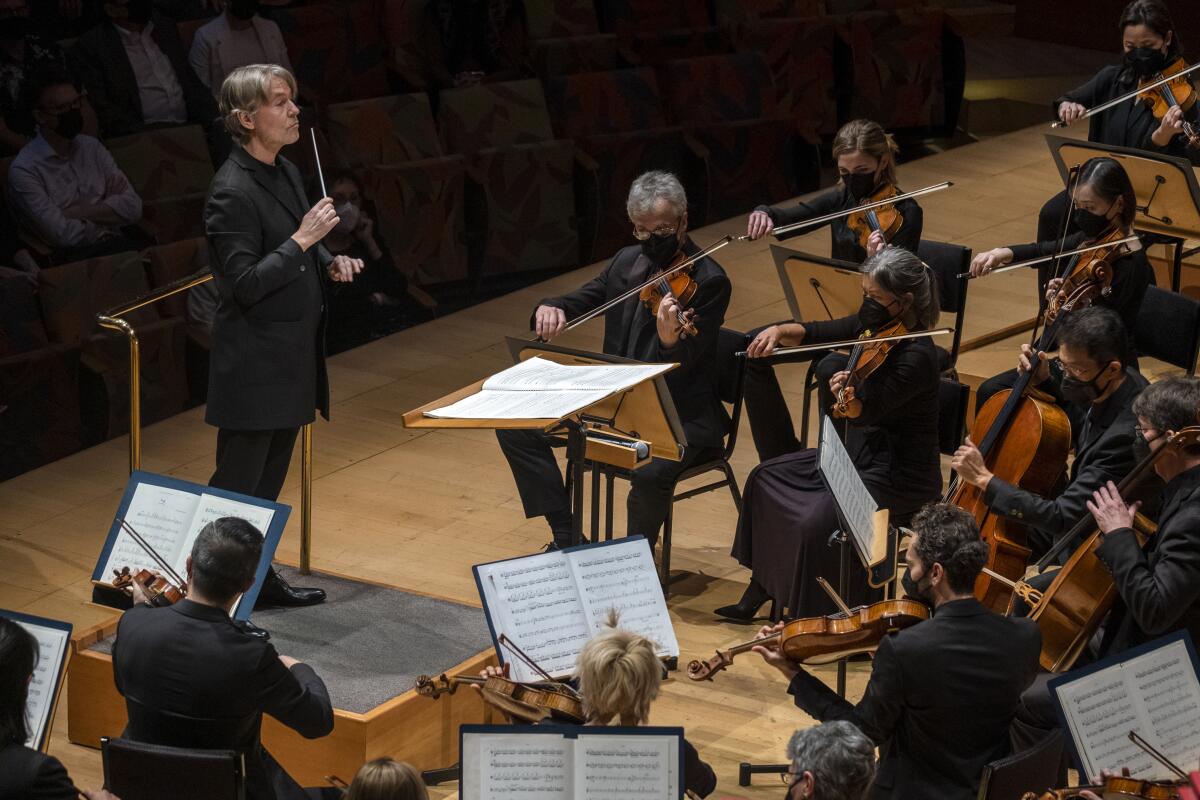Review: A new piano concerto by Daníel Bjarnason gets a little help from Edgar Allan Poe

When it comes to new music written during the pandemic, composers have tended, on the one hand, to reflect loneliness, isolation and sorrow. On the other hand, they’ve sought the restorative glow in simply being alive and able to make music in a time of trouble and deprivation.
But Icelandic composer Daníel Bjarnason won’t have any of that. “FEAST,” his piano concerto given its premiere by the Los Angeles Philharmonic at Walt Disney Concert Hall over the weekend, is a darkly luminous dance of death, inspired by Edgar Allan Poe’s “The Masque of the Red Death.”
“The ‘Red Death’ had long devastated the country. No pestilence had been ever so fatal, or so hideous,” begins Poe’s 1842 tale about a prince who parties with revelers safely locked away in his posh castle while the hoi polloi outside perish. What Poe labeled “A Fantasy” 180 years ago now sounds readily believable in Los Angeles.
It must have seemed believable to Bjarnason as well, who turned to Poe as he finished his concerto this year. Written for the star Icelandic pianist Vikingur Ólafsson, “FEAST” was the centerpiece of Esa-Pekka Salonen’s program over the weekend. On Sunday, the day I heard the concerto, Iceland — though a model country in its response to the pandemic — nonetheless had the highest number of COVID-19 cases per 100,000 people in the world, only making Poe’s “Fantasy” all the less fantastical.
The intersection of melancholy and wonder is a familiar feature of Icelandic music, be it Björk or Bjarnason. When Bjarnason’s Violin Concerto had its premiere at the Hollywood Bowl in 2017, the soloist began by whistling and playing the violin at the same time as if solemnly summoning the stars above. Two years later, Bjarnason turned the tables in his “From Space I Saw Earth,” written to celebrate the L.A. Phil’s 100th anniversary. Here he imagined in sound his looking down on us from afar.
Similarly, Bjarnason’s journal of plague years in this concerto is more global than personal. In it time marches on. The beyond remains always the beyond. Pandemic gloom can be countered by its reminding us of the meaning of now.
The program Bjarnason suggests for “FEAST” begins with a revel, conveyed by inviting scales rising in the orchestra and the solo piano. There come suggestions of shutting the world out, enmeshing the listener in the plush luxury of Rachmaninoff-like harmonies. But the clock ticks. Bells toll. First a dance, then a danse macabre. And finally, a procession, a way out. Or maybe that is a way in, to a new appreciation of life.
The concerto has its ups and downs. The pianist lures the listener and then in thundering climaxes brings everything crashing down only to once again make uneasy merriment. At one point the orchestra stops, listens to the silence for a second, and then goes right back to it.
Ólafsson’s lyricism is such that his piano embodies both Bjarnason’s light and the terror. Nothing can dim his beautiful tone, and its survival through it all becomes a symbol of survival. Bjarnason’s sensation of an ominous omniscience lingers, but he has the wonder-inducing talent to not make you feel too bad about that.
The concerto had originally been scheduled for last season to be conducted by Gustavo Dudamel, who planned Beethoven’s Seventh Symphony as a companion. Salonen, in the second and final week of his annual L.A. Phil residency as the orchestra’s conductor laureate, omnisciently surrounded what turned out to be a very different “FEAST” written a year later with two grave, big-picture, wonder-intense early 20th century works. The first, Bartók’s Music for Strings, Percussion and Celesta, revels in the mechanics of the universe.
The strings are divided into two groups and operate in contrapuntal dialogue, building a universe in sound from the lowest notes. For Bartók, the universe is a structural masterpiece to be represented in the fugue and dance. But he has his hand in wonder, as well, the percussion evoking the mystery of night and its sounds in the slow movement.
Sibelius, in his Seventh Symphony, which followed “FEAST,” seemingly embraces neither design nor obvious dramatic intent. Yet it, like both Bartók’s score and Bjarnason’s, begins with a slow upward movement, music slowly emerging out of deep recesses.
The symphony has the most mystery of all. Sibelius wrote it in 1924, his 61st year, and then wrote little else for the next 30 years. On this last symphony (it is rumored the composer burned an eighth symphony), Sibelius is almost like a meditation, letting your thoughts find their own way, which in the most practiced just might lead to enlightenment.
In whatever way Sibelius achieved it, his final symphony can, in the right hands, have a transcendental power. Those hands have been Leonard Bernstein’s and now Salonen’s. The mood is set with a hymnal reverence. Squirrelly little themes in the winds blow in this quasi-religious wind. One thing follows another, related, sense-making but not in any overtly obvious structural way.
What you feel in a great performance is a sense of addition, each detail contributing to a lifting of the spirit. The climactic ending is large and powerful but not huge and overpowering. The symphony sounds like it’s over but doesn’t seem over. The grandeur resonated long after the notes had died away in this rapt, stirring, exceptionally played feast of a performance.
More to Read
The biggest entertainment stories
Get our big stories about Hollywood, film, television, music, arts, culture and more right in your inbox as soon as they publish.
You may occasionally receive promotional content from the Los Angeles Times.











